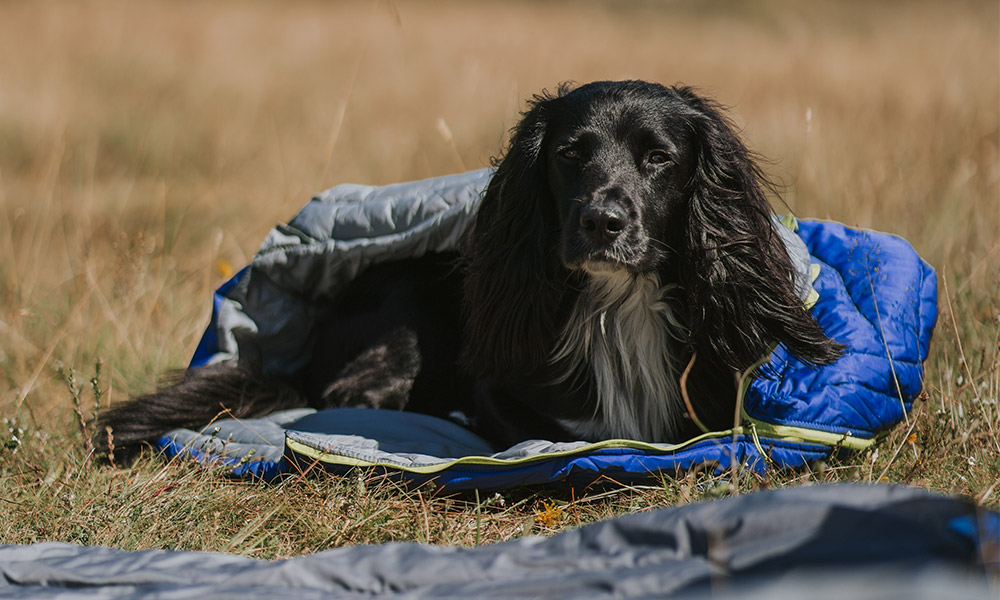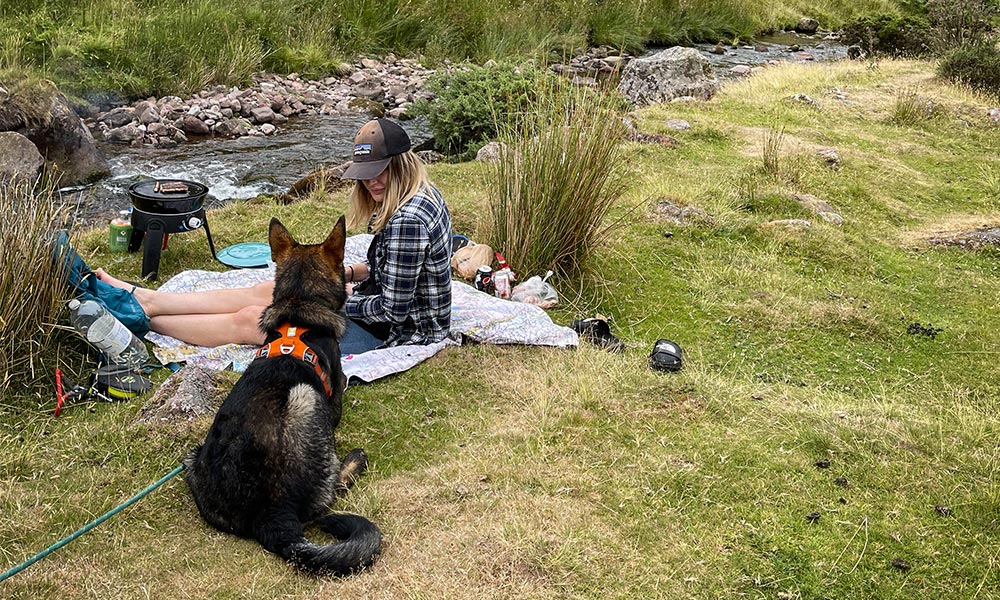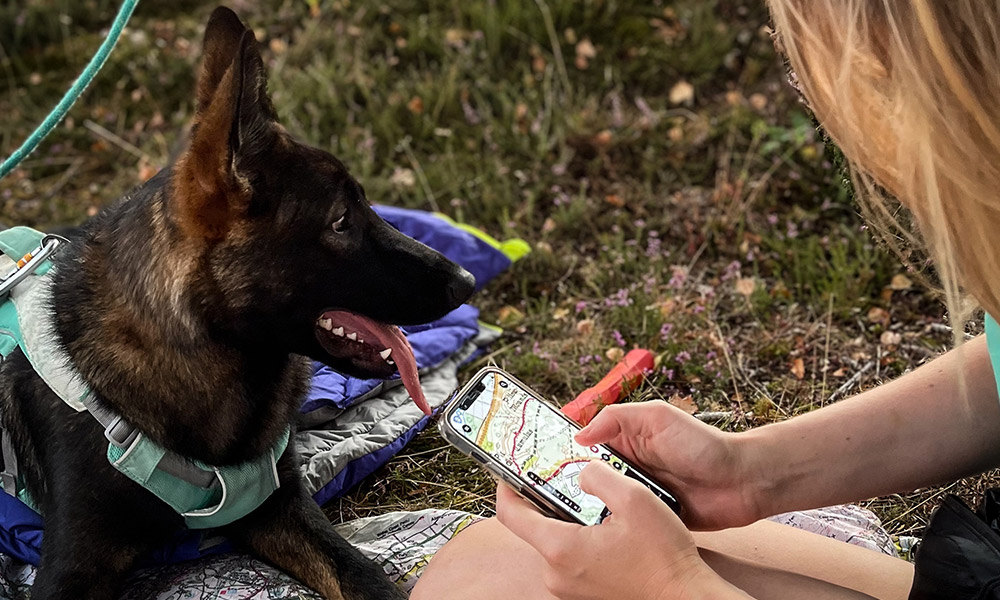Top tips on how to take your dog camping
With an eager attitude, a bit of preparation and the right gear, you’ll be ready to explore the outdoors with your four-legged friend. Here’s our expert guide to camping with dogs to make sure your overnight adventures get off to a good start.
There’s backpacking, then there’s ‘bark’-packing… aka camping with your dog! Taking your dog away with you doesn’t have to be a faff and a night under the star is no exception. Camping with dogs is becoming more and more popular, so why not give it a go? First, you’ll need a plan…..

Camp where dogs are allowed
As you look at potential trails and locations, remember to check whether dogs are allowed, if camping is permitted, and what the lead regulations are. Regulations can differ depending on the area and time of year, so it’s best to research region by region.
Here are some ideas for finding dog-friendly areas:
- If looking to stay at a designated campsite, they will be able to tell you if they allow dogs, which the majority do. Here’s a list of dog-friendly campsites.
- The National Trust is a charity that works to preserve historical buildings and sites whilst also maintaining many hiking trails. Visit their website to find out if that area is dog friendly.
- Check with the town’s tourist information centres for the best dog-friendly walks.
- Ask around, friends with the inside scoop are invaluable. There’s no better way to get insider information on a trail than to ask someone who has hiked it.
- Local outdoor stores are also a good port of call. Staff may know of good dog-friendly walking routes in the area, and they may also stock relevant guidebooks.
- Prioritise routes with plenty of water for a quick way to cool off in the summer, as well as a source of drinking water if you have filtration tablets.
How to get your dog used to camping
Introduce your dog to a tent in advance. Every dog is different, so a practice run gives a sense of your pooch’s comfort level with a tent. You can learn a lot about how they get along by camping out in your garden, if you have one, or test a night’s camping at a local site.

Think about what to pack
If your dog’s ready to carry their own gear, the Ruffwear Approach Pack works for both hiking and backpacking. It has enough room to carry gear for an overnight backpacking trip (or longer if you intend to shoulder some of your dog’s gear), but it isn’t too roomy that it would be an overkill for a day hike.
How do I get my dog used to a pack?
Have your dog wear theirs on walks and short hikes. This will give both of you the chance to get to know the pack and its features. Start with an empty pack, then work up to carrying some weight. Lots of praise, treats and fun go a long way when warming up to a pack.
How much weight can my dog carry in their backpack?
A good rule of thumb is to keep the total carrying weight, including pack and contents, under 25% of your dog’s body weight.
Fitness and breed will affect how much they can carry. First-time pack-wearers or seniors may want to go lighter. Puppies are encouraged to wait until they are fully grown before carrying anything. An empty backpack is a great way to get them used to wearing a pack if they’re too young to bear weight.
What to pack when camping with your dog
In terms of what to pack, think about your dog’s basic needs
Food
Pack what you’d normally feed your dog, plus a little extra for the calories burnt on the trail. Ziploc bags are hard to beat for storage en-route. They keep water out, food in, and can be washed and reused for future trips. To lighten the load, explore freeze dried or dehydrated dog food. Introduce this slowly before your trip though, to avoid an upset tummy.
Water (bowl)
Typically, one bowl works just fine for both food and water. A fabric travel bowl is lightweight and compact – the food versions typically close so can conveniently hold a single meal.
First-aid
There are some great dog-specific first-aid kits. Keep an eye out for gauze, self-adhering bandages/wrap, tick removers, and dog-safe antihistamine. If you’re unsure how to use any of it, you can chat with your vet or even take a dog first-aid course.
Sleep system (warmth and shelter)
The Highlands Sleeping Bag is a go-to. It’s durable and comes with a compression sack. Its warmth is similar to ta 2- or 3- season human sleeping bag, so works in late spring, summer, and early autumn for most dogs.

Other dog camping essentials
- Treats
- Pick-up bags
- Collar with up-to-date tags
- The Beacon Safety Light: a high-performance safety dog light to help keep dogs visible in low-light conditions or inclement weather
- Lead: A Waist lead can all be worn around the waist to keep your hands free
- Hitch: a long lead or dog-hitching system which allows your dog to roam at camp while remaining on lead
- Toys: the Huck-a-Cone is perfect for fetch or tug to keep your pup entertained at camp
Responsible dog camping
Good recall, basic obedience, and commands like ‘leave it’ will keep things positive for your canine companion on the trail.
Know the etiquette for the area you’re hiking or backpacking and be mindful of other users and local wildlife. Trails that allow horses typically require hikers and mountain bikers to yield to horse riders.
At camp, keep your four-legged friend on a lead or within your control. Trying to keep an eye on a roaming dog while setting up camp, building a campfire, or eating dinner can be tricky.
If your camping buddy has a lot to say or loves to let out a good howl at the moon, consider camping in a more secluded area. What’s music to our ears might be less than ideal for others’ wilderness experience. When in doubt, err on the side of courtesy.
Leave no trace
Pack-it-in, pack-it-out! Dog waste should be picked up and packed out in pick-up bags. It helps protect water sources, wildlife, and natural beauty.
Other dog-specific considerations include respecting wildlife by giving other animals space (and not chase), being considerate of other users (through good manners and etiquette), and monitoring and cleaning up food crumbs, spilled kibble, or toys.

Is it safe to camp with a dog
You know your dog better than anyone else and are in the best position to make judgments for their wellbeing. When it comes to medical concerns and wilderness hazards, we recommend talking to your vet ahead of your next campout.
Have fun!
Taking your dog camping for the first time is exciting, but it might also feel daunting. Do your best to prepare ahead of time and have a back-up plan to mitigate for some of those nerves.
Patience and sense of humour will also help. Not all dogs take to sleeping in a tent, or going in and out of tent doors, right away. With practice, though, they will get the hang of it.
Part of what makes camping so fun is that things rarely go exactly as planned, that’s just part of the adventure!







